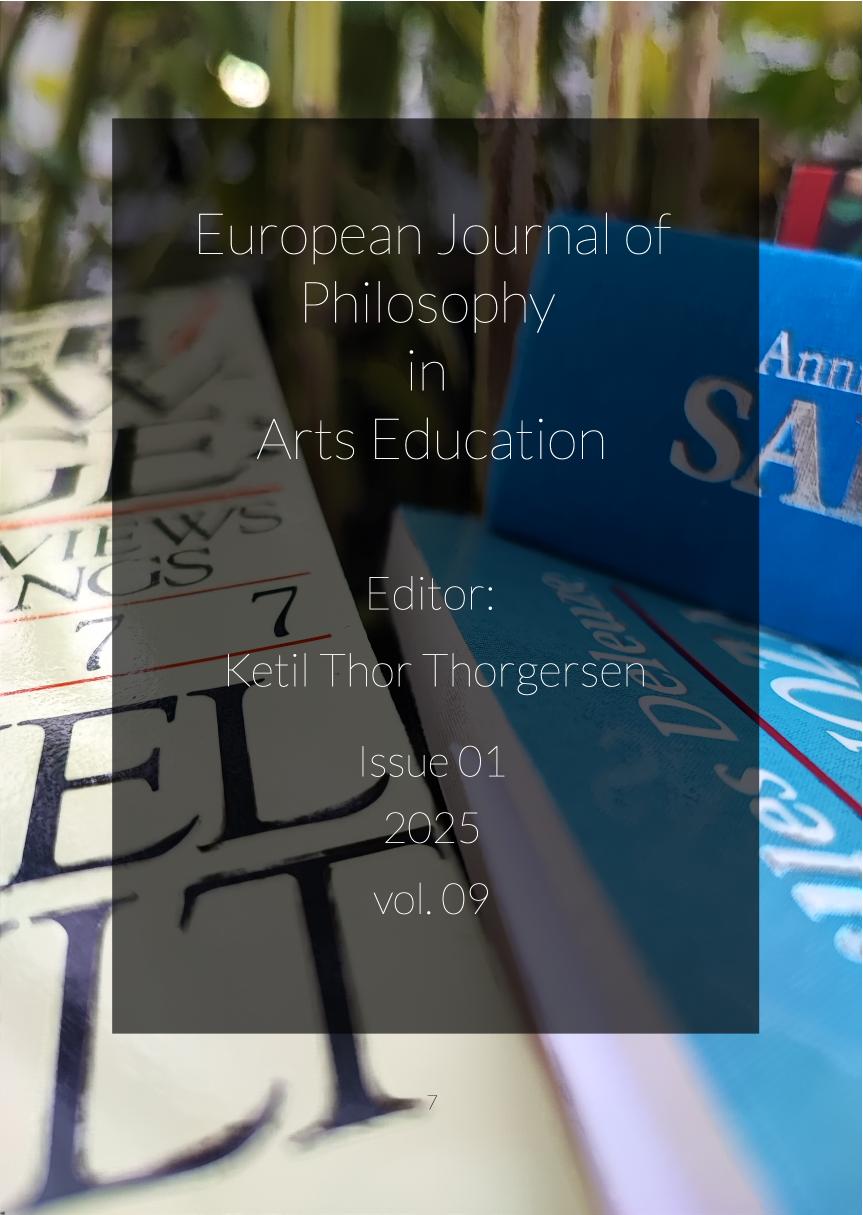Editorial for issue 1 2025
DOI:
https://doi.org/10.5281/zenodo.17288066Abstract
Editorial
2025 issue of the European Journal of Philosophy in Arts Education
Ketil Thorgersen
Editor in Chief
EJPAE is proud to present a new issue that dives into the vital and challenging intersection between the arts, education, and philosophy. In insecure and rapidly changing times of global instability to the pervasive influence of technology in nearly every domain of life, the two articles both provide refreshing takes on critique of institutions. In such troubling times, the arts and arts education are more needed than ever—not as an escape, but as a crucial space for critical reflection, imagining alternatives, and fostering human development beyond the dictates of efficiency and technocracy.
This issue contains two articles that are united by a shared theme: both examine and critique existing institutional structures while suggesting alternative methods that emphasize individual empowerment, creative expression, and community bonds. Collectively, they encourage us to reexamine essential questions regarding the role and possibilities of arts education in today's world. I am particularly pleased to share both, as they offer intriguing insights on how the core elements of the arts—creativity, play, and imagination—can become levers for meaningful change.
The first article is "Re-thinking Conservatory Education as an Open System," by Cecilia Ferm Almqvist. In a unique and personal format, structured as a letter from a piano student to an educational philosopher from former Yugoslavia, Aleksandra Marjanovi?, the author provides a sharp critique of Western classical music conservatory culture. Almqvist illuminates the struggles of students within a "closed system" dominated by the master-apprentice model, competition, and un-reflected tradition. Drawing on Marjanovi?'s philosophical ideas, the article re-thinks higher music education as an "open system" that embraces play, creativity, and imagination to help students develop their own "life plans" as autonomous, democratic musicians. It is a necessary and thought-provoking read for all involved in music education, especially those grappling with how to challenge conservative teaching cultures and the pervasive influence of neo-liberal structures on the arts.
Following this is "Art and Play as Arenas for Resistance and Change: Strategies and Possible Locations," by Eli Bruderman. This article takes a broad philosophical sweep, engaging with the aesthetic theories of Friedrich Schiller and Herbert Marcuse to ask whether art and play can genuinely drive social change, particularly toward Marcuse’s vision of a "society as a work of art." Bruderman argues that institutionalized art, exemplified by the museum, often fails to act as an arena for meaningful resistance, instead serving to domesticate and neutralize subversive energies due to its dependency on technocracy and private capital. The article then proposes an alternative model: "hypo-modernism," a form of grassroots, small-scale, and ethical social-artistic activism that utilizes art and play "from below" to effect real change within communities—a concrete realization of utopian aesthetic play. This essay offers a deep and necessary caution against the domestication of art's critical potential.
Both articles, though addressing different fields of arts education converge in their call to resist the narrowing of artistic purpose and to actively reclaim the potential of creativity and play for building a more humane and democratic society. They powerfully remind us that the philosophical foundation of arts education is always a site for activism, whether personal or communal.
I enjoyed the intellectual stimulation I got through reading these texts, and really hope that even you will get some valuable new epiphanies from taking part in the thoughts of these authors.
Ketil Thor Thorgersen
Editor in Chief Stockholm October 7th 2025

Downloads
Published
Issue
Section
License
Copyright (c) 2025 Ketil Thor Thorgersen

This work is licensed under a Creative Commons Attribution 4.0 International License.
EJPAE provides immediate open access to all its published content. Users do not need to register or pay to read content.
https://creativecommons.org/licenses/by/4.0/
Authors of content published in European Journal of Philosophy in Arts Education (EJPAE) retain the copyright to their works. Content is free to be used by anyone as long as you "[...] give appropriate credit, provide a link to the license, and indicate if changes were made. You may do so in any reasonable manner, but not in any way that suggests the licensor endorses you or your use." and "No additional restrictions — You may not apply legal terms or technological measures that legally restrict others from doing anything the license permits." (from the Creative Commons licence agreement)
EJPAE does not charge any author or publication fees.
Authors are encouraged to deposit the final published version of their article for self-archiving (author's personal website) and/or archiving in an institutional repository immediately upon publication.




